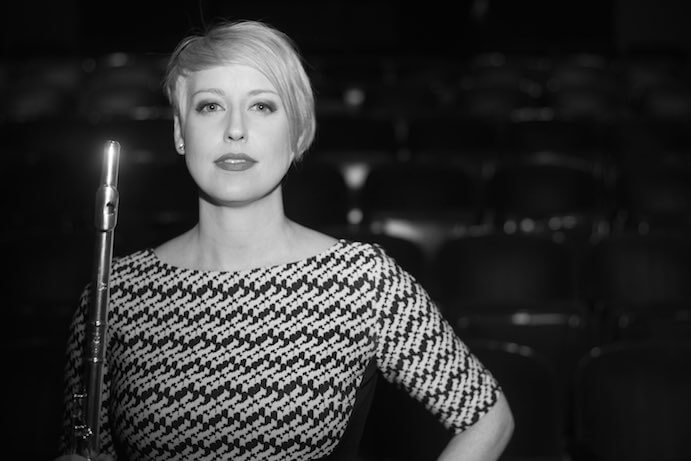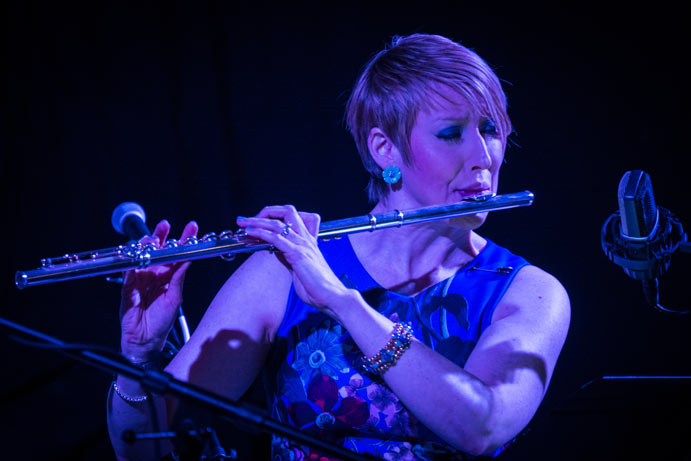The forceful, breathy sounds that initiate flutist Lindsey Goodman’s newest release, Returning to Heights Unseen (Navona Records), encapsulate the spirit of the entire record. Goodman and the composers with whom she has collaborated often blur the line between acoustic and electronic, allowing one world of sound an equal share in the other. The electroacoustic back-and-forth acts as a metaphor in sound for the collaborative effort at the core of Goodman’s project. A quick read through the works’ program notes (all but one of which were written by the composers) reveals close composer-performer relationships developed throughout commission, composition, performance, and recording.
Understandably, only David Stock was unable to contribute a program note to Returning to Heights Unseen. The inimitable composer-conductor, Goodman’s mentor, and founder of The Pittsburgh New Music Ensemble (of which Goodman remains a member) passed away in 2015. According to Goodman’s note, Stock’s A Wedding Prayer was feared lost for a decade until the composer’s widow came upon it after his passing. The piece, written as a wedding gift for Goodman and husband Chris Carmean, was premiered during their ceremony in 2004. The inclusion of this tender, intimate duet gives some indication of how dear this record must be to Goodman’s heart.
Throughout the record, the sound of the purely acoustic flute is brought into relief by the electronics, interacting both within works and between them. The record’s two fully acoustic works–A Wedding Prayer and Roger Zahab’s Suspicion of Nakedness–offer a wonderful reminder of the subtly of the flute’s sound, especially in extended techniques. Often coy and playful, Suspicion of Nakedness employs occasional key clicks for percussive emphasis before finally evaporating into whistle tones.

Lindsey Goodman–Photo by Joshua Brown
Randall Woolf’s The Line of Purples offers similar contrast, but within an electroacoustic context. Its sections for flute alone are a soothing foil to Woolf’s pop-infused, pre-recorded electronics: gritty beats and delicate piano propel the piece through chiastic structure, turning back on itself through the darkly cool bass. Roger Dannenberg’s Separation Logic opens the record. The piece’s responsive electronics dissect and polyphonize the soloist’s sound, seamlessly rematerializing Goodman’s flute as sonic generator. For the Fallen by Judith Shatin closes the album with the pre-recorded sound of a deep tolling bell made from cannons melted after World War I. The flute is plaintive and despairing–anguished flutter tongue, timbral trills, and tongue rams give way to a final lament for those fallen in war. The electronics intensify the expressivity of Goodman’s part, slowly distorting the sound of the bell on course for the work’s climax.
While many of the record’s touching moments radiate from the breathful humanity of Goodman’s playing, the zenith of her performance comes when she is both singer and vocalist. Tony Zilincik introduces Goodman’s voice to the record in his I Asked You, and in so doing prepares some of Returning to Heights Unseen’s most evocative music. The composer posed nine questions; Goodman recorded her answers. The verbal, rhythmic, and melodic content of her speech shape both the fixed audio and the flute part. The speech-melody weaves in and out of the exuberant textures of the first movement, “Everything I Love,” and the placid, otherworldly second movement, “I Play Music.”
On both Sleep’s Undulating Tide by Elainie Lillios and Demon/Daemon by Linda Kernohan, Goodman’s flute and vocal virtuosity continue to shine. In Sleep’s Undulating Tide–Lillios’ atmospheric setting of “Variation’s on the Word Sleep” by Margaret Atwood–Goodman’s performance explores the poem’s fears and its sensuality. Atwood’s final expression of desire, “I would like to be the air / that inhabits you for a moment / only. I would like to be that unnoticed / and that necessary,” transfigures the inscription on the record’s back cover:
“The visible breath, artificial and serene, of inspiration returning to heights unseen.”

Lindsey Goodman performs BGSU faculty composer Elainie Lillios’ Undulating Tide #NMG2017 (photo: Tina Tallon/SALT Arts Documentation)
This quotation is taken from “L’Apres-midi d’un Faune” by Stéphane Mallarmé, the inspiration for Debussy’s prelude famous for its flute solo. Kernohan’s Demon/Daemon capitalizes on this text and infamous melody, creating a drama in miniature during which the flutist struggles to learn the Debussy. As the performer’s exasperation with the process grows, the performer’s breathing becomes more audible. Over the course of the piece, breaths become gasps become whispers and inward singing until the final line of the piece is sung outright: “Did I love a dream.”
What is this dream? Goodman’s personal relationships with this album’s composers reveal a musician whose collaborative work infuses her artistry. And collaboration is not so easily contained. Goodman dedicates her record “to the 137 backers who lovingly crowdfunded the project through Indiegogo.” Perhaps this record is the dream. The audible breath, inspired sound: Returning to Heights Unseen.























